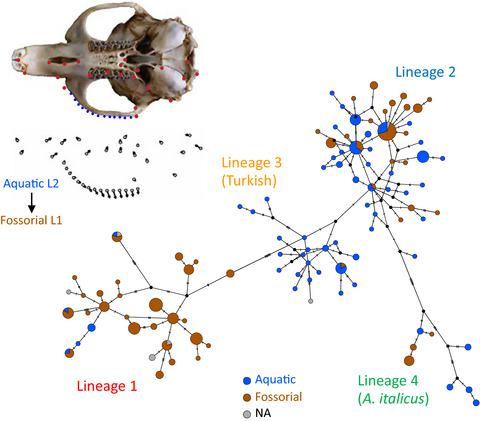当前位置:
X-MOL 学术
›
J. Zool. Syst. Evol. Res.
›
论文详情
Our official English website, www.x-mol.net, welcomes your feedback! (Note: you will need to create a separate account there.)
Genetic structure, ecological versatility, and skull shape differentiation in Arvicola water voles (Rodentia, Cricetidae)
Journal of Zoological Systematics and Evolutionary Research ( IF 1.9 ) Pub Date : 2020-05-13 , DOI: 10.1111/jzs.12384 Pascale Chevret 1 , Sabrina Renaud 1 , Zeycan Helvaci 2 , Rainer G. Ulrich 3 , Jean‐Pierre Quéré 4 , Johan R. Michaux 2, 5
Journal of Zoological Systematics and Evolutionary Research ( IF 1.9 ) Pub Date : 2020-05-13 , DOI: 10.1111/jzs.12384 Pascale Chevret 1 , Sabrina Renaud 1 , Zeycan Helvaci 2 , Rainer G. Ulrich 3 , Jean‐Pierre Quéré 4 , Johan R. Michaux 2, 5
Affiliation

|
Water voles from the genus Arvicola display an amazing ecological versatility, with aquatic and fossorial populations. The Southern water vole (Arvicola sapidus) is largely accepted as a valid species, as well as the newly described Arvicola persicus. In contrast, the taxonomic status and evolutionary relationships within Arvicola amphibius sensu lato had caused a long‐standing debate. The phylogenetic relationships among Arvicola were reconstructed using the mitochondrial cytochrome b gene. Four lineages within A. amphibius s.l. were identified with good support: Western European, Eurasiatic, Italian, and Turkish lineages. Fossorial and aquatic forms were found together in all well‐sampled lineages, evidencing that ecotypes do not correspond to distinct species. However, the Western European lineage mostly includes fossorial forms whereas the Eurasiatic lineage tends to include mostly aquatic forms. A morphometric analysis of skull shape evidenced a convergence of aquatic forms of the Eurasiatic lineage toward the typically aquatic shape of A. sapidus. The fossorial form of the Western European lineage, in contrast, displayed morphological adaptation to tooth‐digging behavior, with expanded zygomatic arches and proodont incisors. Fossorial Eurasiatic forms displayed intermediate morphologies. This suggests a plastic component of skull shape variation, combined with a genetic component selected by the dominant ecology in each lineage. Integrating genetic distances and other biological data suggest that the Italian lineage may correspond to an incipient species (Arvicola italicus). The three other lineages most probably correspond to phylogeographic variations of a single species (A. amphibius), encompassing the former A. amphibius, Arvicola terrestris, Arvicola scherman, and Arvicola monticola.
中文翻译:

Arvicola 水田鼠(啮齿目、仓鼠科)的遗传结构、生态多样性和头骨形状分化
Arvicola 属的水田鼠表现出惊人的生态多样性,具有水生和化石种群。南方水田鼠 (Arvicola sapidus) 以及新描述的 Arvicola persicus 在很大程度上被认为是有效的物种。相比之下,Arvicola amphibius sensu lato 的分类地位和进化关系引起了长期的争论。使用线粒体细胞色素 b 基因重建 Arvicola 之间的系统发育关系。A. amphibius sl 中的四个谱系得到了很好的支持:西欧、欧亚大陆、意大利和土耳其谱系。在所有采样良好的谱系中都发现了化石和水生形式,这证明生态型不对应于不同的物种。然而,西欧系主要包括化石形式,而欧亚系主要包括水生形式。头骨形状的形态测量分析表明,欧亚世系的水生形态趋向于典型的水生 A. sapidus 形态。相比之下,西欧谱系的颅骨形态表现出对牙齿挖掘行为的形态适应,具有扩大的颧弓和牙列切牙。古欧亚大陆形态显示出中间形态。这表明头骨形状变异的可塑性成分与每个谱系中优势生态选择的遗传成分相结合。整合遗传距离和其他生物学数据表明,意大利血统可能对应于一个早期物种(Arvicola italicus)。
更新日期:2020-05-13
中文翻译:

Arvicola 水田鼠(啮齿目、仓鼠科)的遗传结构、生态多样性和头骨形状分化
Arvicola 属的水田鼠表现出惊人的生态多样性,具有水生和化石种群。南方水田鼠 (Arvicola sapidus) 以及新描述的 Arvicola persicus 在很大程度上被认为是有效的物种。相比之下,Arvicola amphibius sensu lato 的分类地位和进化关系引起了长期的争论。使用线粒体细胞色素 b 基因重建 Arvicola 之间的系统发育关系。A. amphibius sl 中的四个谱系得到了很好的支持:西欧、欧亚大陆、意大利和土耳其谱系。在所有采样良好的谱系中都发现了化石和水生形式,这证明生态型不对应于不同的物种。然而,西欧系主要包括化石形式,而欧亚系主要包括水生形式。头骨形状的形态测量分析表明,欧亚世系的水生形态趋向于典型的水生 A. sapidus 形态。相比之下,西欧谱系的颅骨形态表现出对牙齿挖掘行为的形态适应,具有扩大的颧弓和牙列切牙。古欧亚大陆形态显示出中间形态。这表明头骨形状变异的可塑性成分与每个谱系中优势生态选择的遗传成分相结合。整合遗传距离和其他生物学数据表明,意大利血统可能对应于一个早期物种(Arvicola italicus)。


























 京公网安备 11010802027423号
京公网安备 11010802027423号